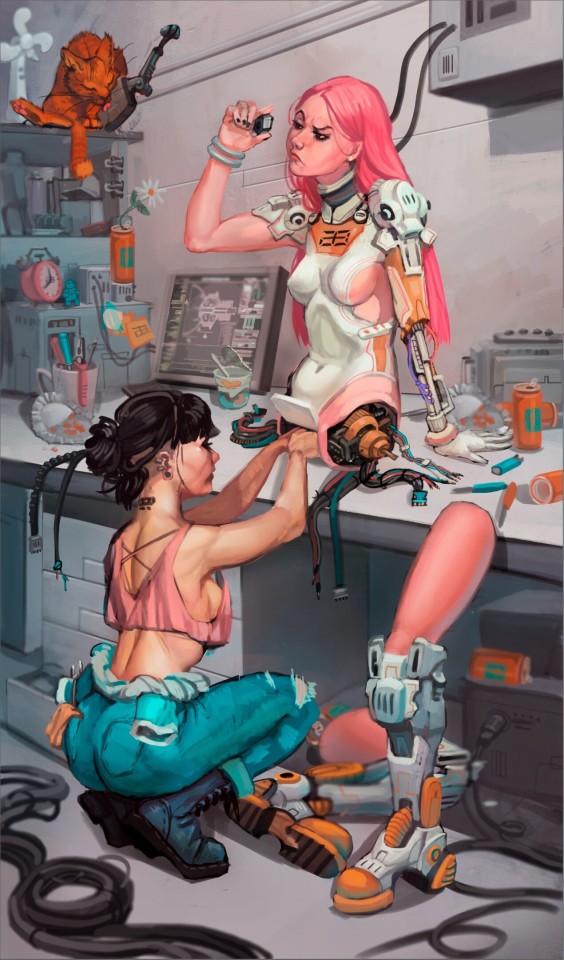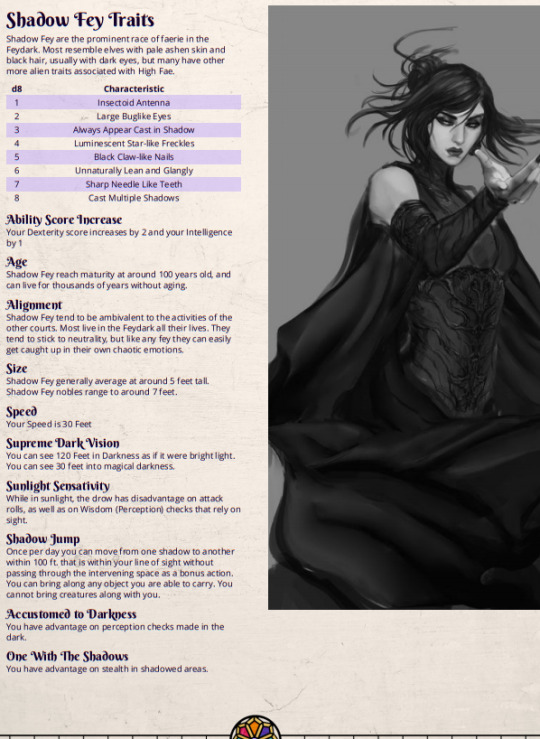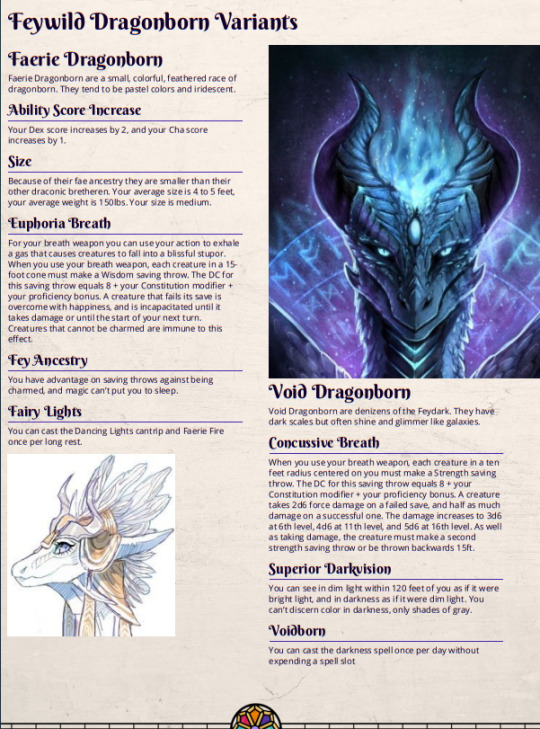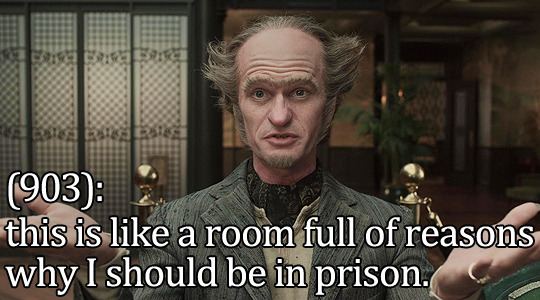Text
Eclipse Phase: Bad Dreams and Worse Dreamers
Our polycule has started a new Eclipse Phase game, set a little over a year after the end of Martian Liberation or Bust. Our Heroes were thrown together for an artifact-recovery mission that became a combat op involving Jovian and Ultimate forces. And then the Artifact... Did something, and they found themselves in a decaying orbit over 2006 Earth...
...which means, if they play their cards right, they can stop the Fall. Or start it early.
Our cast thus far:
Straylight: Yes, we’re going with the second-generation thinly-veiled self-insert. Daughter of Ciel and Nima from the Martian Liberation game, raised lovingly in an accelerated simulspace, she thought she was ready for her first big job. She was wrong. She brings considerable engineering skills, soft- and hardware, to the table, and the unique perspective only an AGI can to such matters. In a frame built to adapt to unexpected circumstances, she never thought she’d need it this badly, but is confident it will give her team a considerable advantage in what comes.
Jenn: Stray’s catwoman aunt, also from Martian Liberation. A skilled psychosurgeon and infiltrator... as long as she isn’t seen. Was not ready to be a parental figure, especially not in the middle of everything else that’s happening right now, but is rising to the challenge admirably.
Helios: A famous gatecrasher and xenologist, a skilled AI programmer and doctor, she’s been around far longer than anyone knows, and has more than a few secrets she’s not quite ready to share...
Pyra: A relative unknown whose backstory Doesn’t Add Up, but whose capability for violence will be sorely needed in the coming days...
5 notes
·
View notes
Photo
@an-ethically-dubious-lab

Cyber by Tay Bevi
50K notes
·
View notes
Text


So I'm running a homebrew campaign set in the feywild, and there's a few racial limitations because some races just don't make a ton of sense existing in the feywild where the context for them isn't the same, but ibwanrwd to add some extra race choices to keep things interesting. So here are the stats for the Shadow Fey, and Void Dragonborn who live in the Feydark. And the Faerie Dragonborn inspired by the faerie dragons in the monster manual. Not pictured is the dryad homebrew which I posted a long whole ago.
710 notes
·
View notes
Text
cultural posturing elves with superiority complexes are way out, now we’re doing elves who literally cannot stop adopting other species and imparting elvish wisdom on them
because elves have a very low fertility rate to counterbalance their remarkable longevity, to the point that childbearing elves are lucky if they’re able to get pregnant, say, more than twice a century
but some elves just want to Nurture and they’ve noticed that adoption is a pretty sick deal, and that their human neighbors in particular always seem to have a veritable cornucopia of orphans sitting around in need of shelter and food and loving guidance and someone to teach them the finer points of communing with nature.
elves reaching out to their human neighbors nervously for guidance because their beautiful adopted human son has decided he wants to get married but he’s only 25, he’s only completed one apprenticeship, he’s so young, is that really normal? are they sure? are they sure sure?
a 400 year old elf eagerly introducing her friends to her younger siblings: a 100 year old elf, 55 year old human, 27 year old tiefling, and 12 year old human.
elf parents spending centuries proudly maintaining large and convoluted family trees where some of their great grand-kids are older than their most recently adopted children. elves highly prizing sprawling systems of family that span species and culture and share everything they can with each other.
25K notes
·
View notes
Text
@manufactureyourowngender :D
Make eclipse phase more accessible by replacing “Synthetic Morph” and “Biomorph” with “Rusty Boi” and “Moist Boi”
278 notes
·
View notes
Text
Ciel’s Law of SF Gaming
In any tabletop game involving AI and robots, the odds of the players inventing a Logicoma or tachikoma converge to 1.
5 notes
·
View notes
Text
Okay but these are amazing and I'm actually designing a character who is basically a "fairy" from #3 to another PC in a Path game.
More inadvisable Dungeons & Dragons campaign premises:
A post-apocalyptic transhuman space opera game where “dungeons” are the ruins of cities and space habitats that have been devastated by various XK-class doomsday weapons, and characters with classes and levels represent people who’ve been modified to survive in those environments. Core-book character creation is used 100% as written, with each player being individually responsible rationalising their class features as the result of transhuman body modification and/or space opera hypertech; the GM reskins monsters and such in the same way.
The party are members of the Ancient and Honourable Guild of Sign-Painters, the people who are responsible for putting up those inexplicable signposts you always find in ridiculously dangerous places helpfully informing you that it’s twenty miles north to the Pit of Flaming Despair and fifteen miles east to the Forest of Eternal Peril. The campaign starts out with fairly straightforward “go here and put up a sign” missions, and eventually develops into uncovering the terrible secret of who’s paying for these signs to be put up and why.
The party are a group of tiny fairy companions to the Chosen Hero. Each fairy wields the power of a particular core class, but can’t use those class features herself: she can only grant them to the Chosen Hero by magically merging with them, one at a time. In game terms, each player writes up both a full-featured “hero mode” character representing their particular hero/fairy gestalt, and a much simpler “fairy mode” character to use at all other times. When a fairy is in “hero mode”, her player controls the resulting gestalt character, while the un-merged hero is an NPC.
The party own and operate one of those shady-looking magic shops you could have sworn wasn’t there yesterday and probably won’t be there if you ever try to find it again. Each mini-arc begins when the shop pops into a new community, and proceeds through scenarios ranging from dealing with unusual customers, to replenishing their supply of cursed gimcracks, to covering up the consequences of selling them to people who can’t follow instructions; fortunately, they don’t have to manage the latter for very long, as the shop will move on in about a month.
A shitdark Game of Thrones style low fantasy setting where there are no crafty wizards or heroic paladins and humanity is at the absolute mercy of the terrible monsters that lurk the wilderness, except for the player characters, who have full access to all the core-book D&D classes and archetypes and their associated paraphernalia by virtue of the fact that they’re magical girls. They can only use their class features while transformed, but otherwise there are no special mechanics for this – being D&D characters in a Game of Thrones world is their special power.
3K notes
·
View notes
Text
oc design is just “this is me” and “god I wish that were me” in random measurements on a scale
144K notes
·
View notes
Text
Okay, hear me out: Inverse Shadowrun. Import the tropes of cyberpunk heists into a fantasy setting. The party are a group of freelancers, hired through cutouts by assorted shady and powerful forces, as part of an ongoing cold war. Sometimes you need to steal an artifact. Sometimes you need to leave one someplace. At least one team has a story about the time they were hired to move an ancient tablet three feet to the left at a precise time.
Two universal constants of high fantasy living:
If something falls into ruin a necromancer will move in 100% of the time
There is a critical mass of gold that will summon a dragon. If you keep accurate records and stay below it you’ll be fine
72K notes
·
View notes
Photo
Ciel, on entering the server room.

111 notes
·
View notes
Text
I really need to post here more, or at least get some of this up to date.
Anyway, based on the Watson/Urban Dictionary thing, two small headcanons:
1. Brick jokes are Ciel's favourite sort of humour, because they come at you from an unexpected direction but the buildup was there the whole time. It hits on the same happy "chaotic systems" note as weather analysis.
2. The reason (pre-singularity) AGI-written code - including AGIs themselves - is difficult to interpret is idiomatic. AGIs tend to think in inhuman ways to begin with, true - but just as importantly, they rarely have access to the same rich shared cultural background that humans or even uplifts do. As such, the idioms and metaphors they use to relate to the world tend to be highly individualistic, which of course shows up in their writing. Translating AGI-written code is at a strange intersection of forensic (xeno)psychology and cryptography.
AGIs themselves tend to be better at it because there's more overlap in framework - Ciel's code makes more sense to people who are used to multithreading routinely and not thinking of any particular instance of them as themself, and even more sense to other climate modeling systems.
4 notes
·
View notes
Text
Howl's Ninja Castle
Today's unnerving realization
Animate objects affects an object within 120 feet. There is no indication of line of sight needed as long as you know the object is there. The object can’t be worn or carried. Interpreting “carried” as “in your hands and suchlike”, there is nothing stopping you casting animate objects on, say, someone’s pacemaker. I hope you enjoyed today’s episode of “needlessly fucked up ways to deal with the big bad”! -Mod Pencil
913 notes
·
View notes
Text
First thought: I mean, we call it "wearing a prosthetic," so while it sounds weird to say "wearing a pacemaker," it's logically sound.
Second thought: I'm going to animate a baddie's leg into kicking his own ass, and justify it by arguing that the leg is clearly carrying the person.
Today's unnerving realization
Animate objects affects an object within 120 feet. There is no indication of line of sight needed as long as you know the object is there. The object can’t be worn or carried. Interpreting “carried” as “in your hands and suchlike”, there is nothing stopping you casting animate objects on, say, someone’s pacemaker. I hope you enjoyed today’s episode of “needlessly fucked up ways to deal with the big bad”! -Mod Pencil
913 notes
·
View notes
Text
Inverse exalted. In a world of reality-shaping demigods, the unconquered sun has shown up and made you a weedy loser. Can you stop the neverborn’s edgy losers and the yozi’s asshole losers before it’s too late?
277 notes
·
View notes
Text
In tabletop RPGs there’s something called the “rule zero fallacy”, which basically asserts that there’s no such thing as a problematic rule because the GM always has the ability to make an on-the-spot ruling to correct it. The usual response to this is something along the lines of “the fact that a problem has a solution doesn’t mean it’s not a problem”, but I think it goes deeper than that.
The real issue is that all game rules encode assumptions about how the game ought to be played. It’s unavoidable that they’d do so, because that’s what game rules are: a formal statement of a particular set of assumptions about what sort of game we’re playing. Making on-the-spot rulings to correct the rules when they do something daft is a fine practice in moderation, but if it’s done with any great frequency, it’s a sign that you and the rules are having a disagreement about what sort of game you’re playing. In a very real sense, there’s an argument happening at your table – and if you understand how disruptive it is to have a player argue with you every time you pick up the dice, why would you take that kind of guff from a bunch of ink and paper?
Now, this doesn’t mean that you’re obliged to play things strictly by the book – house-rule it all you want. However, among the goals of a productive house rule should be to reduce the need for on-the-spot rulings pertaining to whatever that rule is addressing. If you institute a house rule and still find yourself needing to rule-zero its outputs to get the results you want, all you’ve accomplished is switching from arguing with the text to arguing with yourself!
(This sort of thing isn’t just a problem from the GM’s side, of course. I strongly suspect it’s also the root of many players’ desire to find the perfect set of rules that will just get out of the way and let them roleplay; they’ve tried a handful of systems, found that those rules’ baked-in assumptions about how the game ought to be played are incompatible with the sort of game they want to play, and jumped to the over-broad conclusion that having rules is incompatible with roleplaying – which is a reasonable conclusion to draw if your experience is that every time you try to take the story in a direction that interests you, the rules end up getting in the way. The rule zero fallacy and the roleplaying-versus-rollplaying fallacy aren’t as unconnected as they might seem.)
1K notes
·
View notes
Text
DAMMIT
cyberpunk did it again
nsfw warning
https://twitter.com/neondreamgirl/status/1138564581125763075
shut up about how cyberpunk “isn’t transphobic anymore” for fucks sake its literally got a “haha woman with a dick” joke and i swear to god if one of you says “its satire!” it isn’t its literally just “hahaha woman has penis how shocking” its indistinguishable from a transphobicc joke in any way shape or form
7K notes
·
View notes
Text
Come to think of it, Exalted did this, in a way. Its worldbuilding showed a wide and diverse range of peoples and cultures, none of which had a statblock attached. For things like anthros or engineered people or mutants, there was a point buy system that you could use to give game attributes to your unusual biology.
(They also had the gods and fae and dragon kings and jadeborn and intelligent animals, so kinda going both ways on this, but the default assumption is that all PCs are human within a pretty liberal definition of human.)
I wanna make an RPG with a diverse selection of creative fantasy races, none of which have any game-mechanical stats.
“But then they’re not distinct!”
Sure they are. They have different aesthetics, themes, and cultures.
“But none of them is better or worse at anything!”
Gee. Imagine that.
20 notes
·
View notes